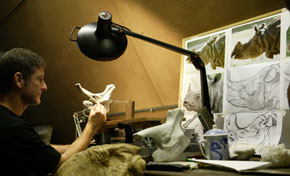Ellison Project
Mick Ellison
One of the challenges for paleontologists is reconstructing the appearance of animals that are long extinct and have no close living relatives. For this reason, working with artists is an integral part of paleontology. Artists who work in paleontology are usually scientific illustrators, a profession that employs creativity and drawing skill within the strict rules of scientific research. Paleontological illustrators often work closely with scientific research staff on particular projects. They need an excellent grasp of anatomy as well as drawing and photographic techniques.
Mick Ellison is a scientific illustrator and photographer in the Division of Paleontology at the American Museum of Natural History. He studied art at the Edinburgh Art College in Scotland and received his BFA in 1987 at the Maryland Institute College of Art. He joined the staff of the AMNH in 1990. His work has appeared on the covers of Nature, Science, Natural History Magazine, and the Science Times section of The New York Times. Mick’s work at the AMNH requires extensive travel, most notably to Asia, where he has been on expeditions in China, Mongolia, Thailand and Myanmar.
As part of the Perissodactyl project, Mick worked with two AMNH research associates, Dr. Matthew Mihlbachler and Dr. Nikos Solounias of the New York College of Osteopathic Medicine on a new reconstruction of the Central Asian brontothere Embolotherium. Mihlbachler and Solounias had carried out a research project on this animal; their results suggested that the structure previously interpreted as a horn in Embolotherium actually supported a very greatly enlarged nose. Mick’s task was to produce an accurate reconstruction of this bizarre looking mammal. In the following pages, Mick describes the process of reconstructing the appearance of two different species of Embolotherium, E. andrewsi and E. grangeri.
If you want to find out more about scientific illustration history and techniques, check out this excellent website at the Smithsonian Institution’s National Museum of Natural History

